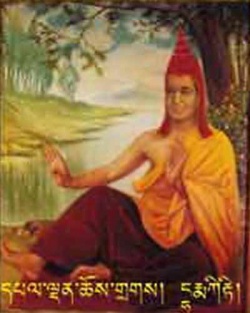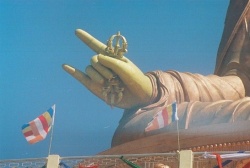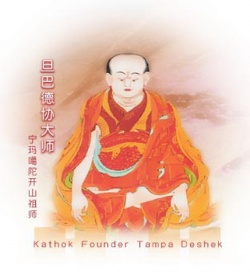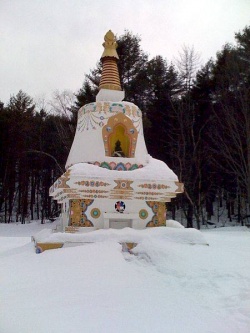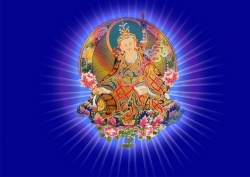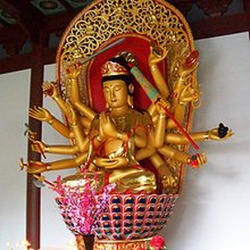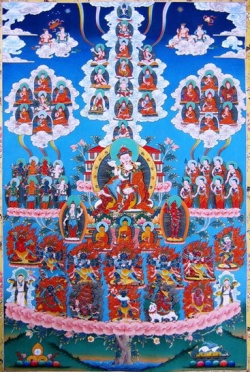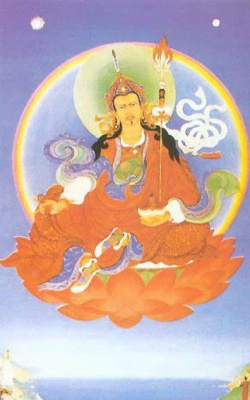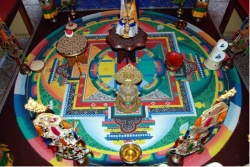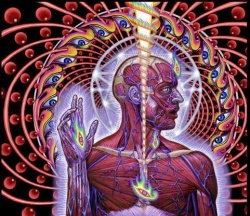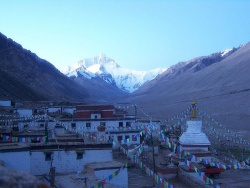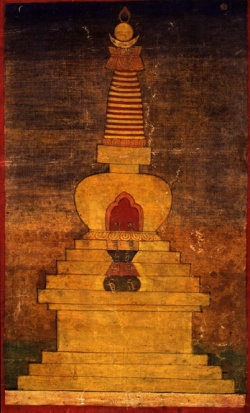Difference between revisions of "Yana"
(Created page with "thumb|250px| <poem> Yāna (Sanskrit and Pāli: "vehicle") refers to a mode or method of spiritual practice in Buddhism, and in particular to divisions of ...") |
m (Text replacement - "Nomenclature" to "Nomenclature") |
||
| (8 intermediate revisions by 2 users not shown) | |||
| Line 1: | Line 1: | ||
[[File:Chodak.jpg|thumb|250px|]] | [[File:Chodak.jpg|thumb|250px|]] | ||
| − | |||
| − | |||
| − | |||
| − | |||
| − | |||
| − | |||
| − | |||
| − | |||
| − | 1.33 And then the Lord came to the River Ganges. And just then, the river was so full that a crow could drink out of it. And some people were looking for a boat, and some were looking for a raft, and some were binding together a raft of reeds to get to the other side. But the Lord, as swiftly as a strong man might stretch out his flexed arm or flex it again, vanished from this side of the Ganges and reappeared with his order of monks on the other shore. | + | |
| − | 1.34 And the Lord saw those people who were looking for a boat, looking for a raft, and binding together a raft of reeds to get to the other side. And seeing their intentions, he uttered this verse on the spot: | + | |
| + | <poem> | ||
| + | [[Yāna]] ([[Sanskrit]] and [[Pāli]]: "[[vehicle]]") refers to a mode or method of [[spiritual]] practice in [[Buddhism]], and in particular to divisions of various [[schools of Buddhism]] according to their type of practice. | ||
| + | [[File:0054.gif|thumb|250px|]] | ||
| + | Nomenclature, {{Wiki|etymology}} and {{Wiki|orthography}} | ||
| + | [[File:657db.jpg|thumb|250px|]] | ||
| + | In [[form]], [[yāna]] is a neuter [[action]] {{Wiki|noun}} (comparable to an {{Wiki|English}} gerund) derived from the [[Sanskrit]] [[root]] yā- meaning "go" or "move", using any means of locomotion, by land or sea. Hence it may be translated "going", "moving", "marching, a march", "riding, a ride", "travelling, travel", "journey" and so on. | ||
| + | [[File:01a.jpg|thumb|250px|]] | ||
| + | The [[word]] came to be extended to refer to any means used to ease or {{Wiki|speed}} travel: hence such meanings as "[[vehicle]]", "carriage", "vessel", "wagon", "ship", and so on, depending on context. "[[Vehicle]]" is often used as a preferred translation as the [[word]] that provides the least in the way of presuppositions about the mode of travel. | ||
| + | [[File:445454 guru.JPG|thumb|250px|]] | ||
| + | In [[spiritual]] uses, the [[word]] [[yāna]] acquires many {{Wiki|metaphorical}} meanings, discussed below. | ||
| + | [[Teaching]] story and {{Wiki|metaphor}} | ||
| + | [[File:450px-Karme_chöling_purkong.jpg|thumb|250px|]] | ||
| + | In the [[Mahāparinibbāna Sutta]] (1.33-34), [[Shakyamuni Buddha]] relates a profound [[teaching]] story on 'vehicles' of conveyance utilizing the [[sacred]] [[river]] [[Ganges]], all of which may be engaged as a {{Wiki|metaphor}} for "[[yana]]" and a [[gradual]] or direct [[path]]: | ||
| + | [[File:1318.JPG|thumb|250px|]] | ||
| + | 1.33 And then the [[Lord]] came to the [[River]] [[Ganges]]. And just then, the [[river]] was so full that a [[crow]] could drink out of it. And some [[people]] were looking for a boat, and some were looking for a raft, and some were binding together a raft of reeds to get to the other side. But the [[Lord]], as swiftly as a strong man might stretch out his flexed arm or flex it again, vanished from this side of the [[Ganges]] and reappeared with his [[order of monks]] on the other shore. | ||
| + | 1.34 And the [[Lord]] saw those [[people]] who were looking for a boat, looking for a raft, and binding together a raft of reeds to get to the other side. And [[seeing]] their {{Wiki|intentions}}, he uttered this verse on the spot: | ||
[[File:22.jpeg|thumb|250px|]] | [[File:22.jpeg|thumb|250px|]] | ||
'When they want to cross the sea, the lake or pond, | 'When they want to cross the sea, the lake or pond, | ||
| − | People make a bridge or raft - the wise have crossed already.' | + | [[People]] make a bridge or raft - the [[wise]] have crossed already.' |
| − | + | [[File:0dc2b6.JPG|thumb|250px|]] | |
| − | These two verses are meant to teach that all vehicles, teachings and doctrine are skillful means (Skt.upāya). | + | These two verses are meant to teach that all vehicles, teachings and [[doctrine]] are [[skillful means]] (Skt.[[upāya]]). |
| − | Introduction and qualification of the term yana | + | Introduction and qualification of the term [[yana]] |
| − | + | [[File:162 1.jpg|thumb|250px|]] | |
| − | The Bodhipathapradīpa of Atisha (980-1054 CE), quoted in Gampopa's (1079-1153 CE) Jewel Ornament of Liberation rendered into English by Günther, makes reference to people of three capacities: | + | The [[Bodhipathapradīpa]] of [[Atisha]] (980-1054 CE), quoted in [[Gampopa's]] (1079-1153 CE) [[Jewel Ornament of Liberation]] rendered into {{Wiki|English}} by [[Günther]], makes reference to [[people]] of three capacities: |
| − | + | [[File:17ds.jpg|thumb|250px|]] | |
| − | Man is to be known in three ways: | + | Man is to be known in [[three ways]]: |
| − | As inferior, mediocre and excellent. | + | As {{Wiki|inferior}}, mediocre and {{Wiki|excellent}}. |
| − | + | [[File:219437.jpg|thumb|250px|]] | |
He who by any means whatsoever | He who by any means whatsoever | ||
| − | Provides for the pleasures of Saṃsāra | + | Provides for the [[pleasures]] of [[Saṃsāra]] |
For himself alone, | For himself alone, | ||
| − | Is called an inferior man. | + | Is called an {{Wiki|inferior}} man. |
| − | + | [[File:798px-China107.jpg|thumb|250px|]] | |
| − | He who turns his back to the pleasures of the world | + | He who turns his back to the [[pleasures]] of the [[world]] |
| − | And abstains from evil deeds, | + | And abstains from [[evil]] [[deeds]], |
| − | But provides only for his own peace, | + | But provides only for his [[own]] [[peace]], |
Is called a mediocre man. | Is called a mediocre man. | ||
| − | + | [[File:22.jpeg|thumb|250px|]] | |
He who seriously wants to dispel | He who seriously wants to dispel | ||
| − | All the misery of others, | + | All the [[misery]] of others, |
| − | Because in the stream of his own being he has understood the nature of misery, | + | Because in the {{Wiki|stream}} of his [[own]] being he has understood the {{Wiki|nature}} of [[misery]], |
| − | Is an excellent man. | + | Is an {{Wiki|excellent}} man. |
| − | + | [[File:953 stupa.jpg|thumb|250px|]] | |
| − | Yana is determined by capacity and propensity of the "precious human body" wrought by merit, not by a specific teaching or lineage, as Gampopa states: | + | [[Yana]] is determined by capacity and {{Wiki|propensity}} of the "[[precious]] [[human]] [[body]]" wrought by [[merit]], not by a specific [[teaching]] or [[lineage]], as [[Gampopa]] states: |
| − | Therefore, because of the difficulty of its attainment, of the uneasiness of its breaking down, and of its great usefulness, we should think of the body as a boat and by its means escape from the ocean of Saṃsāra. As is written: | + | Therefore, because of the difficulty of its [[attainment]], of the uneasiness of its breaking down, and of its great usefulness, we should think of the [[body]] as a boat and by its means escape from the ocean of [[Saṃsāra]]. As is written: |
| − | Standing in the boat of the human body, | + | [[Standing]] in the boat of the [[human]] [[body]], |
| − | You should cross the great flood of misery. | + | You should cross the great flood of [[misery]]. |
Since later this boat is difficult to get, | Since later this boat is difficult to get, | ||
| − | Do not sleep now, you fool. | + | Do not [[sleep]] now, you fool. |
| − | Empowerment, initiation, intention and endeavour may leaven capacity and propensity as may a graceful benediction of a person (in the sense of mindstream), object or place endowed or invested with holiness. In the teaching story abovementioned, Shakyamuni Buddhi and his sangha traverse the continuum directly in the body of their own experience rather than constructing a gradual vehicle for passage. | + | [[Empowerment]], [[initiation]], [[intention]] and endeavour may leaven capacity and {{Wiki|propensity}} as may a graceful benediction of a [[person]] (in the [[sense]] of [[mindstream]]), [[object]] or place endowed or invested with holiness. In the [[teaching]] story abovementioned, [[Shakyamuni]] [[Buddhi]] and his [[sangha]] traverse the {{Wiki|continuum}} directly in the [[body]] of their [[own]] [[experience]] rather than constructing a [[gradual]] [[vehicle]] for passage. |
Usage | Usage | ||
| − | In Buddhism and Hinduism, both yāna and mārga (road or path) are metaphors depicting spiritual practice as a path or journey. Ancient texts in both religions discuss doctrines and practices associated with various yānas. In Buddhism, yāna often expands the metaphor of the spiritual path with the idea of various vehicles that convey a person along that path. The yāna / mārga metaphor pervasive within Buddhism and other traditions is an analogue to the Chinese metaphor of the Tao: The Tao though is the Way as the | + | In [[Buddhism]] and [[Hinduism]], both [[yāna]] and [[mārga]] (road or [[path]]) are {{Wiki|metaphors}} depicting [[spiritual]] practice as a [[path]] or journey. {{Wiki|Ancient}} texts in both [[religions]] discuss [[doctrines]] and practices associated with various [[yānas]]. In [[Buddhism]], [[yāna]] often expands the {{Wiki|metaphor}} of the [[spiritual]] [[path]] with the [[idea]] of various vehicles that convey a [[person]] along that [[path]]. The [[yāna]] / [[mārga]] {{Wiki|metaphor}} {{Wiki|pervasive}} within [[Buddhism]] and other [[traditions]] is an analogue to the {{Wiki|Chinese}} {{Wiki|metaphor}} of the {{Wiki|Tao}}: The {{Wiki|Tao}} though is the Way as the end goal and not just the [[art]] of wayfinding. The dialogic [[spiritual]] [[traditions]] of [[Indian]] and {{Wiki|Chinese culture}} hold common {{Wiki|cultural}} {{Wiki|memes}}. |
| − | Vedic origins of -yāna as a spiritual journey | + | {{Wiki|Vedic}} origins of -[[yāna]] as a [[spiritual]] journey |
| − | The use of yāna to use as a name or to refer to a spiritual journey may date to the Ṛgveda, possibly composed circa 1500 BCE, whose 10th Mandala makes several references to devayāna, (translators usually render this as the "path of the gods" or similar) and one reference to pitṛyāna ("path of the fathers"). The first verse of the Ṛgveda's burial hymn (10.18) translates approximately as "O Death, take the other path, which is distinct from the way of the gods" (paraṃ mṛtyo anu parehi panthāṃ yaste sva itaro devayānāt). The "other path" is the pitṛyāna, referred to in hymn 10.2 and alluded to in 10.14 and 10.16. | + | The use of [[yāna]] to use as a [[name]] or to refer to a [[spiritual]] journey may date to the [[Ṛgveda]], possibly composed circa 1500 BCE, whose 10th [[Mandala]] makes several references to [[devayāna]], ([[translators]] usually render this as the "[[path]] of the [[gods]]" or similar) and one reference to [[pitṛyāna]] ("[[path]] of the fathers"). The first verse of the {{Wiki|Ṛgveda's}} burial hymn (10.18) translates approximately as "O [[Death]], take the other [[path]], which is {{Wiki|distinct}} from the way of the [[gods]]" (paraṃ mṛtyo anu parehi panthāṃ yaste [[sva]] itaro devayānāt). The "other [[path]]" is the [[pitṛyāna]], referred to in hymn 10.2 and alluded to in 10.14 and 10.16. |
| − | The devayāna and pitṛyāna evolved from the ancient Rig Vedic concern for immortality to the classical Hindu concern with ending saṃsāric existence. The Upaniṣads, which comment on the Vedas, make further reference to devayāna and pitṛyāna. Among other distinctions, the pitryana was said to refer the religious practices of villagers, and the devayāna was said to refer to the practices of recluses living in the forest. The Bṛhadaraṇyaka Upaniṣad (II.iv.11 and IV.v.12) also makes reference to ekayāna, notably in the phrase vedānāṃ vāk ekayānam, where ekayānam connotes "destination". The phrase translates approximately to "the one destination of the Vedas is the spirit of the word", in the same sense that a river's destination is the ocean. | + | The [[devayāna]] and [[pitṛyāna]] evolved from the {{Wiki|ancient}} Rig {{Wiki|Vedic}} [[concern]] for [[immortality]] to the classical [[Hindu]] [[concern]] with ending [[saṃsāric]] [[existence]]. The {{Wiki|Upaniṣads}}, which comment on the [[Vedas]], make further reference to [[devayāna]] and [[pitṛyāna]]. Among other {{Wiki|distinctions}}, the [[pitryana]] was said to refer the [[religious]] practices of villagers, and the [[devayāna]] was said to refer to the practices of recluses living in the {{Wiki|forest}}. The Bṛhadaraṇyaka {{Wiki|Upaniṣad}} (II.iv.11 and IV.v.12) also makes reference to [[ekayāna]], notably in the [[phrase]] vedānāṃ [[vāk]] ekayānam, where ekayānam connotes "destination". The [[phrase]] translates approximately to "the one destination of the [[Vedas]] is the [[spirit]] of the [[word]]", in the same [[sense]] that a river's destination is the ocean. |
| − | Yāna in the Pāli Canon | + | [[Yāna]] in the [[Pāli Canon]] |
| − | Yāna is one of ten suggested gifts (dana) that a lay person can appropriately give a monk or recluse, in the sense of providing a vehicle or transportation (e.g., see DN 7.33/PTS: A iv 59 and DN 10.177/PTS: A v 269). | + | [[Yāna]] is one of ten suggested gifts ([[dana]]) that a lay [[person]] can appropriately give a [[monk]] or [[recluse]], in the [[sense]] of providing a [[vehicle]] or transportation (e.g., see DN 7.33/PTS: A iv 59 and DN 10.177/PTS: A v 269). |
| − | The earliest explicit Buddhist use of -yāna in a metaphorical sense of a journey to awakening may be the term dhammayānam, "dharma chariot" (SN IV.4), where the vehicle itself serves as an extended metaphor for the Eightfold Path. Various parts of the chariot represent aspects of the Path (magga), e.g. axles represent meditation, the charioteer represents mindfulness, and so on. | + | The earliest explicit [[Buddhist]] use of -[[yāna]] in a {{Wiki|metaphorical}} [[sense]] of a journey to [[awakening]] may be the term [[dhammayānam]], "[[dharma chariot]]" (SN IV.4), where the [[vehicle]] itself serves as an extended {{Wiki|metaphor}} for the [[Eightfold Path]]. Various parts of the [[chariot]] represent aspects of the [[Path]] ([[magga]]), e.g. axles represent [[meditation]], the charioteer represents [[mindfulness]], and so on. |
| − | Thus, metaphorical usage of yāna in the sense of a vehicle (as distinct from a path) emerged from a Buddhist context, and it did so relatively early in the evolution of Buddhism. Nevertheless, while the Pali Canon are very rich in images of wheels (cakka) and paths (magga) as metaphors for the journey to awakening, the Pali Canon rarely uses the term yāna for that purpose. | + | Thus, {{Wiki|metaphorical}} usage of [[yāna]] in the [[sense]] of a [[vehicle]] (as {{Wiki|distinct}} from a [[path]]) emerged from a [[Buddhist]] context, and it did so relatively early in the [[evolution]] of [[Buddhism]]. Nevertheless, while the [[Pali Canon]] are very rich in images of [[wheels]] ([[cakka]]) and [[paths]] ([[magga]]) as {{Wiki|metaphors}} for the journey to [[awakening]], the [[Pali Canon]] rarely uses the term [[yāna]] for that {{Wiki|purpose}}. |
| − | Enumeration of yānas in Mahayana texts | + | Enumeration of [[yānas]] in [[Mahayana texts]] |
| − | Mahayana texts are very rich in images of vehicles that serve in metaphors for journeys to awakening. | + | [[Mahayana texts]] are very rich in images of [[vehicles]] that serve in {{Wiki|metaphors}} for journeys to [[awakening]]. |
| − | The three carts of expedient means: the parable of the burning house | + | The three carts of [[expedient means]]: the [[parable]] of the burning house |
| − | The tradition of Mahayana texts employing the image of different types of vehicles and conveyances as salient metaphor for the journey of novice to the awakening of adept may have begun with the Lotus Sūtra. The Lotus Sūtra holds a parable of a devoted father with three small children entranced in childhood play within the family home, oblivious that tongues of flame are ravenously engulfing the house. The father entices the children from the burning home with the half-truth gilded promise of special carts for each of them. The carts though are only an expedient means for luring the children from the house, somewhat like the advice to women to scream "fire, fire", when being raped to secure the attention and action of the self-concerned passersby. | + | The [[tradition]] of [[Mahayana texts]] employing the {{Wiki|image}} of different types of vehicles and conveyances as salient {{Wiki|metaphor}} for the journey of [[novice]] to the [[awakening]] of {{Wiki|adept}} may have begun with the [[Lotus Sūtra]]. The [[Lotus Sūtra]] holds a [[parable]] of a devoted father with three small children entranced in childhood play within the [[family]] home, oblivious that tongues of flame are ravenously engulfing the house. The father entices the children from the burning home with the half-truth gilded promise of special carts for each of them. The carts though are only an [[expedient means]] for luring the children from the house, somewhat like the advice to women to scream "[[fire]], [[fire]]", when being raped to secure the [[attention]] and [[action]] of the self-concerned passersby. |
| − | Katō et al. (1975, 2004: p. 89) render thus into English a tract of the Saddharma Puṇḍarīka pertaining to the cart of expedient means and the parable of the burning house: | + | Katō et al. (1975, 2004: p. 89) render thus into {{Wiki|English}} a tract of the [[Saddharma Puṇḍarīka]] pertaining to the cart of [[expedient means]] and the [[parable]] of the burning house: |
| − | "Śāriputra! Even as that elder, though with power in body and arms, yet does not use it but only by diligent tact resoutely saves [his] children from the calamity of the burning house and then gives each of them great carts made of precious things, so it is with the Tathāgata; though he has power and fearlessness, he does not use them, but only by his wise tact does he remove and save all living creatures from the burning house of the triple world, preaching the three vehicles: the śrāvaka, pratyekabuddha, and Buddha vehicle. | + | "[[Śāriputra]]! Even as that elder, though with power in [[body]] and arms, yet does not use it but only by diligent tact resoutely saves [his] children from the calamity of the burning house and then gives each of them great carts made of [[precious]] things, so it is with the [[Tathāgata]]; though he has power and [[fearlessness]], he does not use them, but only by his [[wise]] tact does he remove and save all living creatures from the burning house of the triple [[world]], preaching the [[three vehicles]]: the [[śrāvaka]], [[pratyekabuddha]], and [[Buddha vehicle]]. |
| − | In the parable, the carts are explicitly identified as corresponding to the three types of Buddha: the goat-cart represents the practices leading to the attainment of Arhatship; the deer-cart, Pratyekabuddhahood; and the bullock-cart, Samyaksambuddhahood. The sutra goes on to say these that the teachings of the three vehicles are merely expedient means (upāya). Their purpose is to direct people toward ekayāna, the one vehicle, depicted in the parable as a jeweled cart driven by a white ox. | + | In the [[parable]], the carts are explicitly identified as corresponding to the three types of [[Buddha]]: the goat-cart represents the practices leading to the [[attainment]] of [[Arhatship]]; the deer-cart, [[Pratyekabuddhahood]]; and the bullock-cart, [[Samyaksambuddhahood]]. The [[sutra]] goes on to say these that the teachings of the [[three vehicles]] are merely [[expedient means]] ([[upāya]]). Their {{Wiki|purpose}} is to direct [[people]] toward [[ekayāna]], the one [[vehicle]], depicted in the [[parable]] as a jeweled cart driven by a white {{Wiki|ox}}. |
| − | The relationship of Dharma (Law) and Yana | + | The relationship of [[Dharma]] ([[Law]]) and [[Yana]] |
| − | Tamura et al. (1975, 2004: pp. 14–15) render a section of the Sutra of Innumerable Meanings (Wu-liang-i ching) that relates the relationship of the Law (Dharma) and various teachings as fundamentally determined by the audience and context: | + | Tamura et al. (1975, 2004: pp. 14–15) render a section of the [[Sutra of Innumerable Meanings]] ([[Wu-liang-i ching]]) that relates the relationship of the [[Law]] ([[Dharma]]) and various teachings as fundamentally determined by the audience and context: |
| − | "Good sons! The Law is like water that washes off dirt. As a well, a pond, a stream, a river, a valley stream, a ditch, or a great sea, each alike effectively washes off all kinds of dirt, so the Law-water effectively washes off the dirt of all delusions of living beings. | + | "Good sons! The [[Law]] is like [[water]] that washes off dirt. As a well, a pond, a {{Wiki|stream}}, a [[river]], a valley {{Wiki|stream}}, a ditch, or a great sea, each alike effectively washes off all kinds of dirt, so the Law-water effectively washes off the dirt of all [[delusions]] of [[living beings]]. |
| − | "Good sons! The nature of water is one, but a stream, a river, a well, a pond, a valley stream, a ditch, and a great sea are different from one another. The nature of the Law is like this. There is equality and no differentiation in washing off the dirt of delusions, but the three laws, the four merits, and the two ways§ are not one and the same. | + | "Good sons! The {{Wiki|nature}} of [[water]] is one, but a {{Wiki|stream}}, a [[river]], a well, a pond, a valley {{Wiki|stream}}, a ditch, and a great sea are different from one another. The {{Wiki|nature}} of the [[Law]] is like this. There is equality and no differentiation in washing off the dirt of [[delusions]], but the three laws, the four [[merits]], and the two ways§ are not one and the same. |
| − | "Good sons! Though each washes equally as water, a well is not a pond, a pond is not a stream or a river, nor is a valley stream or a ditch a sea. As the Tathāgata, the world's hero, is free in the Law, all the laws preached by him are also like this. Though preaching at the beginning, in the middle, and at the end all alike effectively wash off the delusions of living beings, the beginning is not the middle, and the middle is not the end. Preaching at the beginning, in the middle, and at the end are the same in expression but different from one another in meaning. | + | "Good sons! Though each washes equally as [[water]], a well is not a pond, a pond is not a {{Wiki|stream}} or a [[river]], nor is a valley {{Wiki|stream}} or a ditch a sea. As the [[Tathāgata]], the world's [[hero]], is free in the [[Law]], all the [[laws]] {{Wiki|preached}} by him are also like this. Though preaching at the beginning, in the middle, and at the end all alike effectively wash off the [[delusions]] of [[living beings]], the beginning is not the middle, and the middle is not the end. Preaching at the beginning, in the middle, and at the end are the same in expression but different from one another in meaning. |
| − | § The three laws are the Four Noble Truths, the Twelve Causes, and the Six Pāramitās...; the four merits are srota-āpanna, sakṛdāgāmin, anāgāmin, and arhat...; and the two ways the Great-vehicle, or Mahayana, and the lesser vehicle, or Hinayana. | + | § The three laws are the [[Four Noble Truths]], the [[Twelve Causes]], and the [[Six Pāramitās]]...; the four [[merits]] are [[srota-āpanna]], [[sakṛdāgāmin]], [[anāgāmin]], and [[arhat]]...; and the two ways the [[Great-vehicle]], or [[Mahayana]], and the [[lesser vehicle]], or [[Hinayana]]. |
| − | Ekayāna (one yana) | + | [[Ekayāna]] (one [[yana]]) |
| − | Mahayana texts such as the Lotus Sutra and the Avatamsaka Sutra sought to unite all the different teachings into a single great way. These texts serve as the inspiration for using the term Ekayāna in the sense of "one vehicle". This "one vehicle" became a key aspect of the doctrines and practices of Tiantai and Tendai Buddhist sects, which subsequently influenced Chán and Zen doctrines and practices. In Japan, the one-vehicle teaching of the Lotus Sutra also inspired the formation of the Nichiren sect. | + | [[Mahayana texts]] such as the [[Lotus Sutra]] and the [[Avatamsaka Sutra]] sought to unite all the different teachings into a single great way. These texts serve as the inspiration for using the term [[Ekayāna]] in the [[sense]] of "one [[vehicle]]". This "one [[vehicle]]" became a key aspect of the [[doctrines]] and practices of [[Tiantai]] and [[Tendai]] [[Buddhist]] sects, which subsequently influenced [[Chán]] and [[Zen]] [[doctrines]] and practices. In [[Japan]], the [[one-vehicle]] [[teaching]] of the [[Lotus Sutra]] also inspired the formation of the [[Nichiren]] [[sect]]. |
| − | Saddharmapundarika Sutra | + | [[Saddharmapundarika Sutra]] |
The stupid and those of little wit, | The stupid and those of little wit, | ||
Those tied to externals, | Those tied to externals, | ||
| − | And the proud cannot believe this Truth. | + | And the proud cannot believe this [[Truth]]. |
But now I gladly and with boldness | But now I gladly and with boldness | ||
| − | In the midst of (you) Bodhisattvas, | + | In the midst of (you) [[Bodhisattvas]], |
Straightway put aside expediency | Straightway put aside expediency | ||
| − | And only proclaim the Supreme Way. | + | And only proclaim the [[Supreme Way]]. |
| − | It was as expedient means | + | It was as [[expedient means]] |
| − | That I expounded a Three-Vehicle Law. | + | That I expounded a Three-Vehicle [[Law]]. |
| − | Let all be free of doubt and perplexity. | + | Let all be free of [[doubt]] and [[perplexity]]. |
| − | World-Honoured Ones, without exception, | + | [[World-Honoured Ones]], without exception, |
| − | Teach this Way: the One Buddha-yana. | + | Teach this Way: the One [[Buddha-yana]]. |
| − | (For) all Buddhas take the one vow: | + | (For) all [[Buddhas]] take the one [[vow]]: |
| − | 'The Buddha-way which I walk, | + | 'The [[Buddha-way]] which I walk, |
| − | I will universally cause all the living | + | I will universally [[cause]] all the living |
To attain this same Way with me.' | To attain this same Way with me.' | ||
| − | Though Buddhas in future ages | + | Though [[Buddhas]] in {{Wiki|future}} ages |
| − | Proclaim hundreds, thousands, kotis, | + | Proclaim hundreds, thousands, [[kotis]], |
| − | Of countless ways into the doctrine, | + | Of countless ways into the [[doctrine]], |
| − | In reality there is but the One-Vehicle. | + | In [[reality]] there is but the One-Vehicle. |
| − | Two yanas | + | Two [[yanas]] |
| − | Traditionally, the two vehicles in Mahāyāna Buddhism consist of Śrāvakayāna and Pratekyabuddhayāna. These in turn refer to doctrines and practices that supposedly aim at becoming two of the three types of Buddha. Mahāyāna Buddhists take a vow to become the third type, namely bodhisattvas. Therefore Mahayana Buddhist texts sometimes use terms like "followers of the two vehicles" to refer to Buddhists who do not accept the Mahayana sutras. | + | [[Traditionally]], the [[two vehicles]] in [[Mahāyāna Buddhism]] consist of [[Śrāvakayāna]] and [[Pratekyabuddhayāna]]. These in turn refer to [[doctrines]] and practices that supposedly [[aim]] at becoming two of the three types of [[Buddha]]. [[Mahāyāna]] [[Buddhists]] take a [[vow]] to become the third type, namely [[bodhisattvas]]. Therefore [[Mahayana Buddhist texts]] sometimes use terms like "followers of the [[two vehicles]]" to refer to [[Buddhists]] who do not accept the [[Mahayana sutras]]. |
| − | Some Mahāyāna sutras consider that the two vehicles together comprise the Hīnayāna – literally, inferior vehicle; sometimes, small vehicle. Modern texts sometimes refer to Mahāyāna and Hīnayāna as "two vehicles". But referring to an "inferior vehicle" is often felt to be disrespectful to those Buddhists who do not consider the Mahāyāna sutras to be the word of the historical Buddha. More commonly, Theravāda refers to most non-Mahāyāna Buddhists in today's world. | + | Some [[Mahāyāna sutras]] consider that the two [[vehicles]] together comprise the [[Hīnayāna]] – literally, {{Wiki|inferior}} [[vehicle]]; sometimes, [[small vehicle]]. {{Wiki|Modern}} texts sometimes refer to [[Mahāyāna]] and [[Hīnayāna]] as "[[two vehicles]]". But referring to an "{{Wiki|inferior}} [[vehicle]]" is often felt to be disrespectful to those [[Buddhists]] who do not consider the [[Mahāyāna sutras]] to be the [[word]] of the [[historical Buddha]]. More commonly, [[Theravāda]] refers to most non-[[Mahāyāna]] [[Buddhists]] in today's [[world]]. |
| − | Three yānas | + | Three [[yānas]] |
| − | Mahāyāna Buddhists often express two different schemata of three yanas. First, here are three paths to liberation that culminate as one of the three types of Buddha: | + | [[Mahāyāna]] [[Buddhists]] often express two different schemata of three [[yanas]]. First, here are three [[paths]] to [[liberation]] that culminate as one of the three types of [[Buddha]]: |
| − | Śrāvakayāna: The Hearer vehicle: A path that meets the goals of an arhat who achieves liberation after listening to the teachings of a samyaksambuddha (fully enlightened buddha). | + | [[Śrāvakayāna]]: The [[Hearer vehicle]]: A [[path]] that meets the goals of an [[arhat]] who achieves [[liberation]] after listening to the teachings of a [[samyaksambuddha]] (fully [[enlightened]] [[buddha]]). |
| − | Pratyekayāna or Pratyekabuddhayāna: The Pratyekabuddha achieves liberation, but does not teach other beings. Pratyekabuddhas do not depend on a teacher and can discover the Dharma even if they do not encounter a buddha. They are sometimes said to remain silent and solitary. | + | [[Pratyekayāna]] or [[Pratyekabuddhayāna]]: The [[Pratyekabuddha]] achieves [[liberation]], but does not teach other [[beings]]. [[Pratyekabuddhas]] do not depend on a [[teacher]] and can discover the [[Dharma]] even if they do not encounter a [[buddha]]. They are sometimes said to remain [[silent]] and {{Wiki|solitary}}. |
| − | Bodhisattvayāna: The bodhisattva attains liberation and wishes to benefit as many beings as possible. A bodhisattva who has accomplished this goal is called a samyaksambuddha. A samyaksambuddha can establish the Dharma and lead disciples to enlightenment. | + | [[Bodhisattvayāna]]: The [[bodhisattva]] attains [[liberation]] and wishes to [[benefit]] as many [[beings]] as possible. A [[bodhisattva]] who has accomplished this goal is called a [[samyaksambuddha]]. A [[samyaksambuddha]] can establish the [[Dharma]] and lead [[disciples]] to [[enlightenment]]. |
| − | A second classification came into use with the rise of the Vajrayāna, which created a hierarchy of the teachings with the Vajrayāna being the highest path. The Vajrayāna itself became multilayered especially in Tibetan Buddhism. | + | A second {{Wiki|classification}} came into use with the rise of the [[Vajrayāna]], which created a {{Wiki|hierarchy}} of the teachings with the [[Vajrayāna]] being the [[highest]] [[path]]. The [[Vajrayāna]] itself became multilayered especially in [[Tibetan Buddhism]]. |
| − | Hīnayāna | + | [[Hīnayāna]] |
| − | Mahāyāna | + | [[Mahāyāna]] |
| − | Vajrayāna | + | [[Vajrayāna]] |
| − | Four yānas | + | Four [[yānas]] |
| − | Mahayana Buddhists sometimes refer to four yanas that subsume the two different schemes of the three yanas: | + | [[Mahayana]] [[Buddhists]] sometimes refer to four [[yanas]] that subsume the two different schemes of the three [[yanas]]: |
| − | Śrāvakayāna | + | [[Śrāvakayāna]] |
| − | Pratyekayāna | + | [[Pratyekayāna]] |
| − | Mahāyāna | + | [[Mahāyāna]] |
| − | Vajrayāna | + | [[Vajrayāna]] |
| − | Five yānas | + | Five [[yānas]] |
| − | This is a Mahāyāna list which is found in East Asian Buddhism. | + | This is a [[Mahāyāna]] list which is found in {{Wiki|East Asian}} [[Buddhism]]. |
| − | Puruṣayāna - the human vehicle. This is the very beginning of the spiritual path | + | [[Puruṣayāna]] - the [[human]] [[vehicle]]. This is the very beginning of the [[spiritual]] [[path]] |
| − | Devayāna - the practice of ethics and meditation | + | [[Devayāna]] - the practice of [[ethics]] and [[meditation]] |
| − | Śrāvakayāna - the practice of renunciation and the Four Noble Truths | + | [[Śrāvakayāna]] - the practice of [[renunciation]] and the [[Four Noble Truths]] |
| − | Pratyekayāna - practice concerned with dependent arising (pratitya-samutpada) | + | [[Pratyekayāna]] - practice concerned with [[dependent arising]] ([[pratitya-samutpada]]) |
| − | Bodhisattvayāna - practice of the Six Perfections | + | [[Bodhisattvayāna]] - practice of the [[Six Perfections]] |
| − | Six yānas | + | Six [[yānas]] |
| − | The five yānas plus the Vajrayāna. This schema is associated with Shingon Buddhism in Japan. It was invented by Kūkai in order to help to differentiate the Vajrayāna teachings that he imported from China in the early 9th century. Kūkai wanted to show that the new teachings were entirely new. | + | The five [[yānas]] plus the [[Vajrayāna]]. This {{Wiki|schema}} is associated with [[Shingon Buddhism]] in [[Japan]]. It was invented by [[Kūkai]] in order to help to differentiate the [[Vajrayāna]] teachings that he imported from [[China]] in the early 9th century. [[Kūkai]] wanted to show that the new teachings were entirely new. |
| − | Nine yānas | + | [[Nine yānas]] |
| − | The Nyingma school of Tibetan Buddhism has nine yanas, a list made by combining the first type of three yanas, and adding the six classes of tantras. | + | The [[Nyingma school]] of [[Tibetan Buddhism]] has [[nine yanas]], a list made by combining the first type of three [[yanas]], and adding the six classes of [[tantras]]. |
| − | Hīnayāna | + | [[Hīnayāna]] |
| − | 1. Śrāvakayāna | + | 1. [[Śrāvakayāna]] |
| − | 2. Pratyekayāna | + | 2. [[Pratyekayāna]] |
| − | Mahāyāna consisting of: | + | [[Mahāyāna]] consisting of: |
| − | 3. Bodhisattvayāna | + | 3. [[Bodhisattvayāna]] |
| − | Vajrayāna, consisting of: | + | [[Vajrayāna]], consisting of: |
| − | Outer Tantras | + | [[Outer Tantras]] |
| − | 4. Kriyatantra | + | 4. [[Kriyatantra]] |
| − | 5. Upatantra (Tibetan spyod rgyud) ‘practice | + | 5. [[Upatantra]] ([[Tibetan]] [[spyod rgyud]]) ‘practice [[tantra]]’ and the [[Ubhayatantra]] ([[gnyis ka’i rgyud]]), ‘[[dual tantra]]’, because it practices the [[view]] of the next [[vehicle]], [[Yogatantra]], together with the [[action]] of the former. |
| − | 6. Yogatantra | + | 6. [[Yogatantra]] |
| − | Inner Tantras | + | [[Inner Tantras]] |
| − | 7. Mahāyoga | + | 7. [[Mahāyoga]] |
| − | 8. Anuyoga | + | 8. [[Anuyoga]] |
| − | 9. Atiyoga (also Dzogchen) | + | 9. [[Atiyoga]] (also [[Dzogchen]]) |
| − | It is important to note that there are numerous untranslated portions of the Vima Nyingthig, Gongpa Sangtal, etc. that place the most secret unsurpassed cycle of Menngagde as a totally independent Buddhist vehicle outside the nine yanas. | + | It is important to note that there are numerous untranslated portions of the [[Vima Nyingthig]], [[Gongpa Sangtal]], etc. that place the most secret [[unsurpassed]] cycle of [[Menngagde]] as a totally {{Wiki|independent}} [[Buddhist]] [[vehicle]] outside the [[nine yanas]]. |
| − | Twelve yanas | + | Twelve [[yanas]] |
| − | Another schema associated with Mahāyāna and Vajrayāna sources: | + | Another {{Wiki|schema}} associated with [[Mahāyāna]] and [[Vajrayāna]] sources: |
| − | Śrāvakayāna | + | [[Śrāvakayāna]] |
| − | Pratyekabuddhayāna | + | [[Pratyekabuddhayāna]] |
| − | Bodhisattvayāna | + | [[Bodhisattvayāna]] |
| − | Kriyayoga | + | [[Kriyayoga]] |
| − | Charyayoga (or Upayoga) | + | [[Charyayoga]] (or [[Upayoga]]) |
| − | Yogatantra | + | [[Yogatantra]] |
| − | Mahayoga | + | [[Mahayoga]] |
| − | Anuyoga | + | [[Anuyoga]] |
| − | Atiyoga | + | [[Atiyoga]] |
| − | Semde | + | [[Semde]] |
| − | Longde | + | [[Longde]] |
| − | Mengagde | + | [[Mengagde]] |
</poem> | </poem> | ||
{{W}} | {{W}} | ||
[[Category:Buddhist Terms]] | [[Category:Buddhist Terms]] | ||
| − | [[Category: | + | [[Category:Yana]] |
Latest revision as of 11:37, 14 December 2015
Yāna (Sanskrit and Pāli: "vehicle") refers to a mode or method of spiritual practice in Buddhism, and in particular to divisions of various schools of Buddhism according to their type of practice.
Nomenclature, etymology and orthography
In form, yāna is a neuter action noun (comparable to an English gerund) derived from the Sanskrit root yā- meaning "go" or "move", using any means of locomotion, by land or sea. Hence it may be translated "going", "moving", "marching, a march", "riding, a ride", "travelling, travel", "journey" and so on.
The word came to be extended to refer to any means used to ease or speed travel: hence such meanings as "vehicle", "carriage", "vessel", "wagon", "ship", and so on, depending on context. "Vehicle" is often used as a preferred translation as the word that provides the least in the way of presuppositions about the mode of travel.
In spiritual uses, the word yāna acquires many metaphorical meanings, discussed below.
Teaching story and metaphor
In the Mahāparinibbāna Sutta (1.33-34), Shakyamuni Buddha relates a profound teaching story on 'vehicles' of conveyance utilizing the sacred river Ganges, all of which may be engaged as a metaphor for "yana" and a gradual or direct path:
1.33 And then the Lord came to the River Ganges. And just then, the river was so full that a crow could drink out of it. And some people were looking for a boat, and some were looking for a raft, and some were binding together a raft of reeds to get to the other side. But the Lord, as swiftly as a strong man might stretch out his flexed arm or flex it again, vanished from this side of the Ganges and reappeared with his order of monks on the other shore.
1.34 And the Lord saw those people who were looking for a boat, looking for a raft, and binding together a raft of reeds to get to the other side. And seeing their intentions, he uttered this verse on the spot:
'When they want to cross the sea, the lake or pond,
People make a bridge or raft - the wise have crossed already.'
These two verses are meant to teach that all vehicles, teachings and doctrine are skillful means (Skt.upāya).
Introduction and qualification of the term yana
The Bodhipathapradīpa of Atisha (980-1054 CE), quoted in Gampopa's (1079-1153 CE) Jewel Ornament of Liberation rendered into English by Günther, makes reference to people of three capacities:
Man is to be known in three ways:
As inferior, mediocre and excellent.
He who by any means whatsoever
Provides for the pleasures of Saṃsāra
For himself alone,
Is called an inferior man.
He who turns his back to the pleasures of the world
And abstains from evil deeds,
But provides only for his own peace,
Is called a mediocre man.
He who seriously wants to dispel
All the misery of others,
Because in the stream of his own being he has understood the nature of misery,
Is an excellent man.
Yana is determined by capacity and propensity of the "precious human body" wrought by merit, not by a specific teaching or lineage, as Gampopa states:
Therefore, because of the difficulty of its attainment, of the uneasiness of its breaking down, and of its great usefulness, we should think of the body as a boat and by its means escape from the ocean of Saṃsāra. As is written:
Standing in the boat of the human body,
You should cross the great flood of misery.
Since later this boat is difficult to get,
Do not sleep now, you fool.
Empowerment, initiation, intention and endeavour may leaven capacity and propensity as may a graceful benediction of a person (in the sense of mindstream), object or place endowed or invested with holiness. In the teaching story abovementioned, Shakyamuni Buddhi and his sangha traverse the continuum directly in the body of their own experience rather than constructing a gradual vehicle for passage.
Usage
In Buddhism and Hinduism, both yāna and mārga (road or path) are metaphors depicting spiritual practice as a path or journey. Ancient texts in both religions discuss doctrines and practices associated with various yānas. In Buddhism, yāna often expands the metaphor of the spiritual path with the idea of various vehicles that convey a person along that path. The yāna / mārga metaphor pervasive within Buddhism and other traditions is an analogue to the Chinese metaphor of the Tao: The Tao though is the Way as the end goal and not just the art of wayfinding. The dialogic spiritual traditions of Indian and Chinese culture hold common cultural memes.
Vedic origins of -yāna as a spiritual journey
The use of yāna to use as a name or to refer to a spiritual journey may date to the Ṛgveda, possibly composed circa 1500 BCE, whose 10th Mandala makes several references to devayāna, (translators usually render this as the "path of the gods" or similar) and one reference to pitṛyāna ("path of the fathers"). The first verse of the Ṛgveda's burial hymn (10.18) translates approximately as "O Death, take the other path, which is distinct from the way of the gods" (paraṃ mṛtyo anu parehi panthāṃ yaste sva itaro devayānāt). The "other path" is the pitṛyāna, referred to in hymn 10.2 and alluded to in 10.14 and 10.16.
The devayāna and pitṛyāna evolved from the ancient Rig Vedic concern for immortality to the classical Hindu concern with ending saṃsāric existence. The Upaniṣads, which comment on the Vedas, make further reference to devayāna and pitṛyāna. Among other distinctions, the pitryana was said to refer the religious practices of villagers, and the devayāna was said to refer to the practices of recluses living in the forest. The Bṛhadaraṇyaka Upaniṣad (II.iv.11 and IV.v.12) also makes reference to ekayāna, notably in the phrase vedānāṃ vāk ekayānam, where ekayānam connotes "destination". The phrase translates approximately to "the one destination of the Vedas is the spirit of the word", in the same sense that a river's destination is the ocean.
Yāna in the Pāli Canon
Yāna is one of ten suggested gifts (dana) that a lay person can appropriately give a monk or recluse, in the sense of providing a vehicle or transportation (e.g., see DN 7.33/PTS: A iv 59 and DN 10.177/PTS: A v 269).
The earliest explicit Buddhist use of -yāna in a metaphorical sense of a journey to awakening may be the term dhammayānam, "dharma chariot" (SN IV.4), where the vehicle itself serves as an extended metaphor for the Eightfold Path. Various parts of the chariot represent aspects of the Path (magga), e.g. axles represent meditation, the charioteer represents mindfulness, and so on.
Thus, metaphorical usage of yāna in the sense of a vehicle (as distinct from a path) emerged from a Buddhist context, and it did so relatively early in the evolution of Buddhism. Nevertheless, while the Pali Canon are very rich in images of wheels (cakka) and paths (magga) as metaphors for the journey to awakening, the Pali Canon rarely uses the term yāna for that purpose.
Enumeration of yānas in Mahayana texts
Mahayana texts are very rich in images of vehicles that serve in metaphors for journeys to awakening.
The three carts of expedient means: the parable of the burning house
The tradition of Mahayana texts employing the image of different types of vehicles and conveyances as salient metaphor for the journey of novice to the awakening of adept may have begun with the Lotus Sūtra. The Lotus Sūtra holds a parable of a devoted father with three small children entranced in childhood play within the family home, oblivious that tongues of flame are ravenously engulfing the house. The father entices the children from the burning home with the half-truth gilded promise of special carts for each of them. The carts though are only an expedient means for luring the children from the house, somewhat like the advice to women to scream "fire, fire", when being raped to secure the attention and action of the self-concerned passersby.
Katō et al. (1975, 2004: p. 89) render thus into English a tract of the Saddharma Puṇḍarīka pertaining to the cart of expedient means and the parable of the burning house:
"Śāriputra! Even as that elder, though with power in body and arms, yet does not use it but only by diligent tact resoutely saves [his] children from the calamity of the burning house and then gives each of them great carts made of precious things, so it is with the Tathāgata; though he has power and fearlessness, he does not use them, but only by his wise tact does he remove and save all living creatures from the burning house of the triple world, preaching the three vehicles: the śrāvaka, pratyekabuddha, and Buddha vehicle.
In the parable, the carts are explicitly identified as corresponding to the three types of Buddha: the goat-cart represents the practices leading to the attainment of Arhatship; the deer-cart, Pratyekabuddhahood; and the bullock-cart, Samyaksambuddhahood. The sutra goes on to say these that the teachings of the three vehicles are merely expedient means (upāya). Their purpose is to direct people toward ekayāna, the one vehicle, depicted in the parable as a jeweled cart driven by a white ox.
The relationship of Dharma (Law) and Yana
Tamura et al. (1975, 2004: pp. 14–15) render a section of the Sutra of Innumerable Meanings (Wu-liang-i ching) that relates the relationship of the Law (Dharma) and various teachings as fundamentally determined by the audience and context:
"Good sons! The Law is like water that washes off dirt. As a well, a pond, a stream, a river, a valley stream, a ditch, or a great sea, each alike effectively washes off all kinds of dirt, so the Law-water effectively washes off the dirt of all delusions of living beings.
"Good sons! The nature of water is one, but a stream, a river, a well, a pond, a valley stream, a ditch, and a great sea are different from one another. The nature of the Law is like this. There is equality and no differentiation in washing off the dirt of delusions, but the three laws, the four merits, and the two ways§ are not one and the same.
"Good sons! Though each washes equally as water, a well is not a pond, a pond is not a stream or a river, nor is a valley stream or a ditch a sea. As the Tathāgata, the world's hero, is free in the Law, all the laws preached by him are also like this. Though preaching at the beginning, in the middle, and at the end all alike effectively wash off the delusions of living beings, the beginning is not the middle, and the middle is not the end. Preaching at the beginning, in the middle, and at the end are the same in expression but different from one another in meaning.
§ The three laws are the Four Noble Truths, the Twelve Causes, and the Six Pāramitās...; the four merits are srota-āpanna, sakṛdāgāmin, anāgāmin, and arhat...; and the two ways the Great-vehicle, or Mahayana, and the lesser vehicle, or Hinayana.
Ekayāna (one yana)
Mahayana texts such as the Lotus Sutra and the Avatamsaka Sutra sought to unite all the different teachings into a single great way. These texts serve as the inspiration for using the term Ekayāna in the sense of "one vehicle". This "one vehicle" became a key aspect of the doctrines and practices of Tiantai and Tendai Buddhist sects, which subsequently influenced Chán and Zen doctrines and practices. In Japan, the one-vehicle teaching of the Lotus Sutra also inspired the formation of the Nichiren sect.
Saddharmapundarika Sutra
The stupid and those of little wit,
Those tied to externals,
And the proud cannot believe this Truth.
But now I gladly and with boldness
In the midst of (you) Bodhisattvas,
Straightway put aside expediency
And only proclaim the Supreme Way.
It was as expedient means
That I expounded a Three-Vehicle Law.
Let all be free of doubt and perplexity.
World-Honoured Ones, without exception,
Teach this Way: the One Buddha-yana.
(For) all Buddhas take the one vow:
'The Buddha-way which I walk,
I will universally cause all the living
To attain this same Way with me.'
Though Buddhas in future ages
Proclaim hundreds, thousands, kotis,
Of countless ways into the doctrine,
In reality there is but the One-Vehicle.
Two yanas
Traditionally, the two vehicles in Mahāyāna Buddhism consist of Śrāvakayāna and Pratekyabuddhayāna. These in turn refer to doctrines and practices that supposedly aim at becoming two of the three types of Buddha. Mahāyāna Buddhists take a vow to become the third type, namely bodhisattvas. Therefore Mahayana Buddhist texts sometimes use terms like "followers of the two vehicles" to refer to Buddhists who do not accept the Mahayana sutras.
Some Mahāyāna sutras consider that the two vehicles together comprise the Hīnayāna – literally, inferior vehicle; sometimes, small vehicle. Modern texts sometimes refer to Mahāyāna and Hīnayāna as "two vehicles". But referring to an "inferior vehicle" is often felt to be disrespectful to those Buddhists who do not consider the Mahāyāna sutras to be the word of the historical Buddha. More commonly, Theravāda refers to most non-Mahāyāna Buddhists in today's world.
Three yānas
Mahāyāna Buddhists often express two different schemata of three yanas. First, here are three paths to liberation that culminate as one of the three types of Buddha:
Śrāvakayāna: The Hearer vehicle: A path that meets the goals of an arhat who achieves liberation after listening to the teachings of a samyaksambuddha (fully enlightened buddha).
Pratyekayāna or Pratyekabuddhayāna: The Pratyekabuddha achieves liberation, but does not teach other beings. Pratyekabuddhas do not depend on a teacher and can discover the Dharma even if they do not encounter a buddha. They are sometimes said to remain silent and solitary.
Bodhisattvayāna: The bodhisattva attains liberation and wishes to benefit as many beings as possible. A bodhisattva who has accomplished this goal is called a samyaksambuddha. A samyaksambuddha can establish the Dharma and lead disciples to enlightenment.
A second classification came into use with the rise of the Vajrayāna, which created a hierarchy of the teachings with the Vajrayāna being the highest path. The Vajrayāna itself became multilayered especially in Tibetan Buddhism.
Hīnayāna
Mahāyāna
Vajrayāna
Four yānas
Mahayana Buddhists sometimes refer to four yanas that subsume the two different schemes of the three yanas:
Śrāvakayāna
Pratyekayāna
Mahāyāna
Vajrayāna
Five yānas
This is a Mahāyāna list which is found in East Asian Buddhism.
Puruṣayāna - the human vehicle. This is the very beginning of the spiritual path
Devayāna - the practice of ethics and meditation
Śrāvakayāna - the practice of renunciation and the Four Noble Truths
Pratyekayāna - practice concerned with dependent arising (pratitya-samutpada)
Bodhisattvayāna - practice of the Six Perfections
Six yānas
The five yānas plus the Vajrayāna. This schema is associated with Shingon Buddhism in Japan. It was invented by Kūkai in order to help to differentiate the Vajrayāna teachings that he imported from China in the early 9th century. Kūkai wanted to show that the new teachings were entirely new.
Nine yānas
The Nyingma school of Tibetan Buddhism has nine yanas, a list made by combining the first type of three yanas, and adding the six classes of tantras.
Hīnayāna
1. Śrāvakayāna
2. Pratyekayāna
Mahāyāna consisting of:
3. Bodhisattvayāna
Vajrayāna, consisting of:
Outer Tantras
4. Kriyatantra
5. Upatantra (Tibetan spyod rgyud) ‘practice tantra’ and the Ubhayatantra (gnyis ka’i rgyud), ‘dual tantra’, because it practices the view of the next vehicle, Yogatantra, together with the action of the former.
6. Yogatantra
Inner Tantras
7. Mahāyoga
8. Anuyoga
9. Atiyoga (also Dzogchen)
It is important to note that there are numerous untranslated portions of the Vima Nyingthig, Gongpa Sangtal, etc. that place the most secret unsurpassed cycle of Menngagde as a totally independent Buddhist vehicle outside the nine yanas.
Twelve yanas
Another schema associated with Mahāyāna and Vajrayāna sources:
Śrāvakayāna
Pratyekabuddhayāna
Bodhisattvayāna
Kriyayoga
Charyayoga (or Upayoga)
Yogatantra
Mahayoga
Anuyoga
Atiyoga
Semde
Longde
Mengagde
